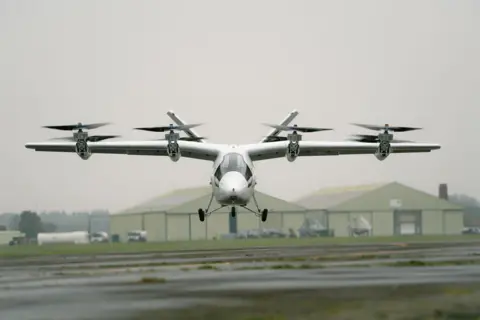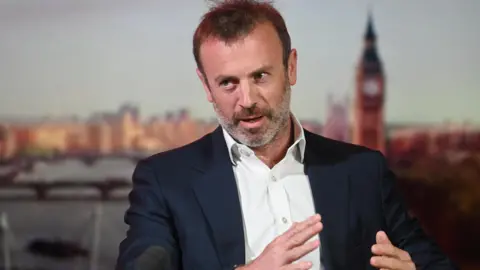Bristol electric ‘flying taxi’ firm gets £39m cash lifeline
 Vertical Aerospace
Vertical AerospaceA company developing a new electric aircraft has announced a major new investment, ensuring its survival.
Vertical Aerospace, based in Bristol, is testing a so-called electric flying taxi which can carry four passengers up to 100 miles (161km).
The firm had been struggling financially, but has secured a $50m (£39m) investment from the US investor, Mudrick Capital.
Stuart Simpson, chief executive of Vertical, called it a “really exciting, pivotal day for the company”.
 Vertical Aerospace
Vertical AerospaceVertical is one many companies around the world trying to develop an all-electric vertical take-off aircraft, or eVTOL.
Its goal is to create an aircraft that is as convenient as a helicopter but which is cheaper to run and does not emit carbon and contribute to climate change.
Vertical was founded in 2016 by British businessman Stephen Fitzpatrick, who also founded the energy firm Ovo.

Mr Fitzpatrick claims the company’s VX4 aircraft will be “100 times safer and quieter” than a helicopter, for one fifth of the cost.
Earlier this month the firm’s engineers passed a new milestone at Cotswold Airport, in Gloucestershire.
For the first time, they flew the aircraft “untethered” – without a safety line to the ground.
It marks the next phase of their testing programme, overseen by the Civil Aviation Authority.
Mr Simpson said: “We are one of only two flying taxis that have a tilt-rotor to have done this in the world, and we’re doing this in the south west of England.
“It’s a phenomenal achievement.”
 Vertical Aerospace
Vertical AerospaceOffering flights without carbon emissions is something of a holy grail for the aerospace industry.
Airbus, GKN and other big aircraft makers are experimenting with hydrogen powered planes.
Another small start-up company is testing hydrogen fuel-cells on small propellor-driven aircraft.
The vertical take-off aircraft requires some very sophisticated engineering.
Eight small rotors mounted on small wings initially lift the aircraft off the tarmac, like a helicopter.
They then tilt to propel the vehicle forwards, offering more stability, and also more engineering risk.
But the finance is almost harder than the physics.
Persuading investors to dig deep enough to keep the company going through long periods of testing and regulation has proved difficult.
Many firms have already folded.
American take-over?
Mr Simpson believes the $50m (£39) injection from Jason Mudrick will keep Vertical running until the end of 2025.
Vertical had racked up £260m of debt and the new deal sees half of that debt converted into equity, owned by distressed debt investor Mudrick Capital.
This means that Jason Mudrick will now own 70% of Vertical’s shares, replacing founder Stephen Fitzpatrick, who is left with 20%.
Mr Fitzpatrick will remain on the board, providing “strategic direction”.
Mudrick Capital has been involved for three years already, and both sides denied talk of a takeover.
Mr Mudrick said: “This agreement underscores our appreciation of Vertical Aerospace’s position in the eVTOL sector and a team that has demonstrated its ability to deliver groundbreaking solutions for the future of sustainable aviation.”
Mr Fitzpatrick said: “The additional equity and stronger balance sheet will enable us to fund the next phase of our development programme and deliver on our mission to bring this amazing electric aircraft to the skies.”
The company has already sold the first 1500 aircraft to blue chip aerospace firms and plans to achieve full CAA certification by 2028 – giving its aircraft permission to fly.
